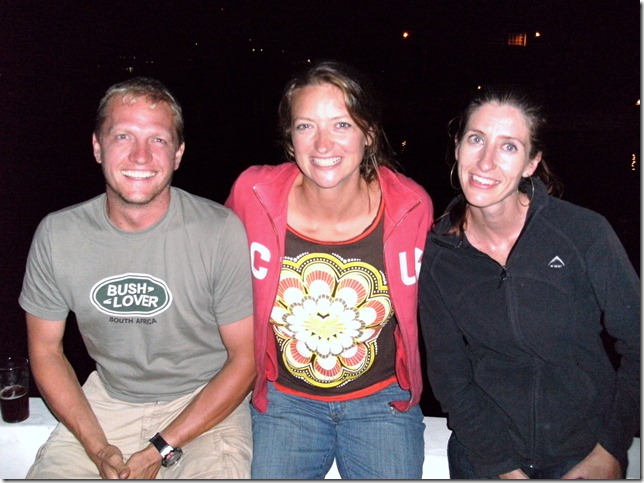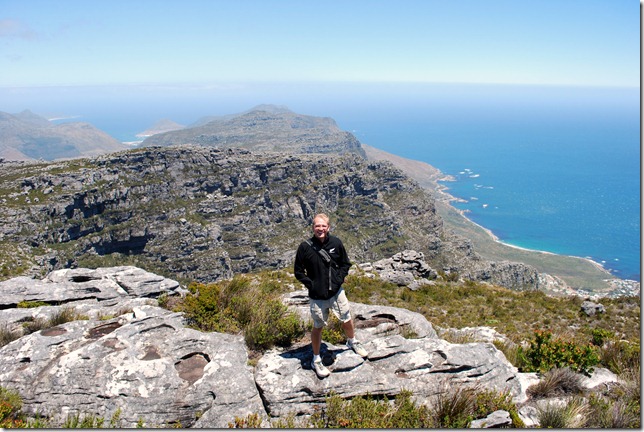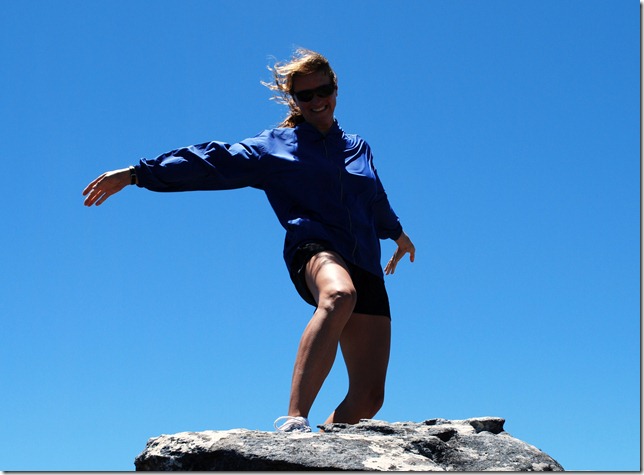Lat: 31 05′ S
Lon: 16 41′ E
After so many full and fun-filled days ashore, I was actually hoping that being offshore would be a bit boring and make it easier to stay caught up on blogging, but it’s been anything but. Oh well, at least we don’t have any excuses about not having the time to blog. Our last couple of days were full of last-minute repairs and socializing. Six or eight boats all took the same weather window out on Wednesday, so there was a big send-off braai on Tuesday night. The grills at the False Bay Yacht Club were filled with boerwors, chicken, steak, sausages, corn, potatoes, and of course a few veggies sausages. As the night wore on, the crowd separated into those who were planning to leave at a particular early hour of the morning (and headed back to their boats) and those whose departure time was contingent how the night played out. The Frenchmen on Revuer de Jour were in especially high spirits as another French boat (a family on a Wharram catamaran) whom they had met in the Indian Ocean had just arrived that day. Maxim and Thibaut pulled out their guitars and began to play, insisting that Lauren join them to sing (her voice is generally in demand wherever we go). They treated us to a number of sing-along songs and performances in both English and French that were both fun and impressive, and Olivier, the father on the Wharram cat pulled out a large bag of his personal reserve of Madagascar rum. We hadn’t had a chance to stop in Madagascar, so we were curious to try it. Madagascar rum is special stuff — think $1 US per liter, harsh, burning 110-proof moonshine. The approach generally used by sailors to drink the stuff is to add natural flavoring (which Madagascar grows in abundance) and sugar to the bottles (which may be water jugs, water bottles, etc.) and then wait a week or so to drink it. Olivier’s personal reserve included vanilla, cinnamon, vanilla and banana, vanilla and Mars bars, ginger and honey, and other flavors from an assortment of plastic containers. We were all strongly encouraged to try every flavor, but needless to say, a little goes a long way. The bartender at the yacht club told us that we were the best group of cruisers to come through since she’s been there and we would definitely have to agree that leaving was bittersweet.
When we left the fuel dock in Simon’s Town we headed straight for Seal Island. It wasn’t on the shortest route out of the bay, but we had time according to the weather forecast and we were keen to see it. It’s one of the few places in the world where great white sharks breach during the seal pup season in winter, waiting near the bottom and then shooting up to the surface and jumping completely out of the icy water as they snare small seal pups learning to swim at the surface. This wasn’t the season for shark spotting, but we did see (and smell) loads of seals. They even swam toward us in groups of 3 or 4, jumping in graceful arcs like dolphins. I had no idea seals jumped like that, so it was pretty fun to watch. We didn’t spot whales leaving the bay like a couple of other boats did, but we did see plenty of seals all the way out. I even had one walk me down the dock in the marina before we left, spinning slowly underwater as he swam beside me, looking up at me as he was spinning and keeping pace with me for nearly the entire dock.
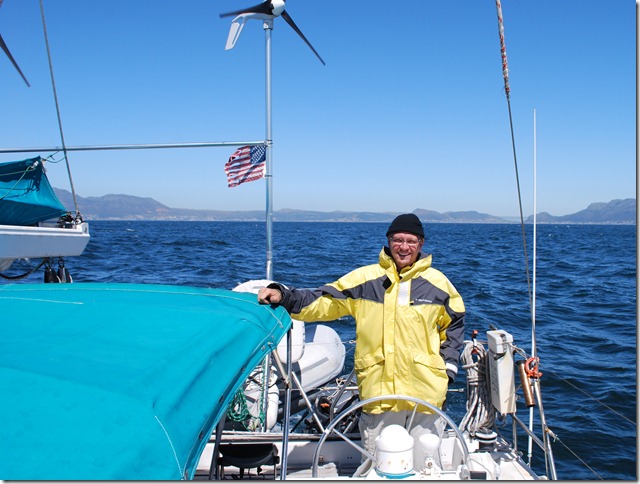 Hopefully we’ll be down with the cold weather clothing soon!
Hopefully we’ll be down with the cold weather clothing soon!
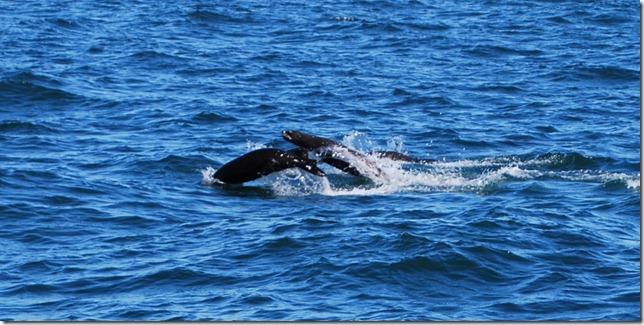 Seals jumping near Seal Island in False Bay
Seals jumping near Seal Island in False Bay
The point of land at the southwest tip of False Bay is the Cape of Good Hope as it’s known to landlubbers, or the Cape of Storms as it was originally and called and and is still thought of by sailors. We gave it a wide berth as we rounded it and Tracey kindly informed us of the South African tradition of calling it the Cape of Good Hope as you’re approaching it and only referring to it as the Cape of Storms once you’re safely around it. The cape and Simon’s Town are usually beset by strong southerly winds (e.g., we had 45+ knots in the marina, had the chartplotter sun cover blown away, and had to patch rips that the wind made in the mainsail cover and bimini) so we’d all picked a rare day with light or northerly winds to leave. We rounded the cape in NW winds, which were good for leaving the bay, but it took a couple of hours before they changed to southerly and allowed us to head north up the coast. I took a nap during that time, and Lauren had to deal with the strong, then light and changing winds. The result was that one of our fishing lines was caught in the port prop by time I woke up. I’d normally jump in and sort it out, but with such icy cold green water I decided to just sort out what I could from above deck and then cut the line. It’s tied off to the rail now and will be at the top of the list when the wind dies offshore or we make it to Luderitz.
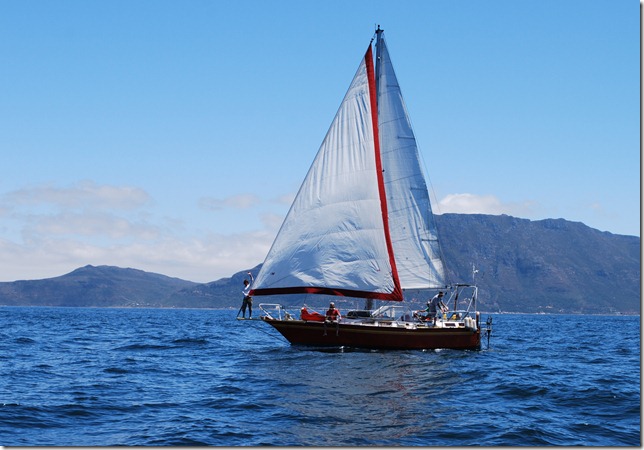 Sailing in light winds beside the French guys on RDJ as we head out of False Bay
Sailing in light winds beside the French guys on RDJ as we head out of False Bay
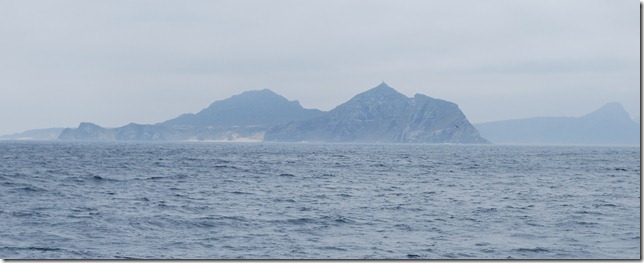 The Cape of Storms (a.k.a. The Cape of Good Hope)
The Cape of Storms (a.k.a. The Cape of Good Hope)
We expected some strong winds and big seas the first couple of days and we weren’t disappointed. The waves from the southerly winds combined with a sizeable SW swell to make things pretty lively. The boats sailing directly to St. Helena have been complaining about the rough conditions, but we have it a bit easier sailing a northerly course and being on a catamaran. It was a bit lively, especially last night, but the boat handled it well as usual, Lauren was able to stay down in the galley long enough to cook some excellent hot meals, Tracey has had no problems with her watches, and nobody’s been doing any seal talking.
So after about 1000 words I’ll get around to the title of the blog and what was really a special experience. The sea last night was amazing. The greenish water here has more phosphorescent plankton that anywhere we’ve been (even more than I had between East London and Simon’s Town). There’s half a waning moon now, so the moon doesn’t rise until about midnight and in the black, starry night the rough seas were so aglow with phosphorescence that I was actually concerned that it would be difficult to spot distant ship’s lights on the horizon. The seas were frothy and white-capped and every disturbance in the water, no matter how small or large gave off a white, slightly green glow. There were so many glowing patches that even in the black night you could see the waves rolling and breaking. It’s unlike anything I’ve seen before, but was sort of like sailing in a rolling, splashing crater of lava, only the glowing bits were greenish white instead of reddish orange. The hulls were surrounded in a bright glow as they pushed through the water and waves that splashed against the windward hull and fell back into the ocean as a thousand droplets looked like a bucket of small white coals being tossed onto the surface of the water. Just before midnight I saw something I’ve heard about and wanted to see but have never seen before. Off to port streaks of light like glowing torpedos with snaking, glowing wakes behind them headed directly for the boat. It was a pod of dolphins. We were much farther offshore than we usually see dolphins, but a pod of 10 or so joined us for nearly an hour. When they swam a few feet underwater you could make out each of their fins as especially bright spots in their glowing shape and wake. You could see their tails glow brightly and pump quickly up and down when they wanted to accelerate and when they broke the surface to breath, their dark forms were silhouetted against the glowing water around them. We watched as the dove, jumped, and darted around, their paths twisting and then fading into soft glows as a group of them would dive down deeper together. As we sailed along watching them, we also saw schools of fish startled by the boat or the dolphins break into smaller brilliant streaks and scatter in every direction, like underwater fireworks. It’s hard to do it justice in words and pictures would never have worked with all the motion and no light, but it was yet another new and unforgettable experience. It was a fitting farewell to South Africa, a vibrant, active, and friendly place that we’ll always remember fondly for all of the wonderful people we’ve met and incredible wildlife we were able to see.
South Africa has made quite an impression on us, and we are not in any hurry to leave, but it’s time. We still have a lot of experiences to share, but we are going to have to catch up on blogging while at sea. Our weather window came as predicted, so we are off to Namibia today!
We have a new crew member coming along. Tracy is a South African who has been working on super-yachts in Fort Lauderdale and in the Mediterranean but is interested in getting some sailing experience. She is extremely nice, well travelled, and keen to learn anything and everything related to sailboats (including engine repair!), so I’m sure that Dallas and I are going to enjoy her company and assistance.
Getting to know Tracy at the good-bye braii
We’re at the fuel dock as we speak (I’m taking advantage of the last minute as usual), so that’s all for now. FYI, I recently posted lots of photos from our recent adventures (see the Photos link above) for your viewing pleasure. We’ll get totally caught up with photos (e.g., from our trip to the township and our hike up Table Mountain) when we get to Luderitz, Namibia in 4-5 days. There are several other boats leaving today as well, so there will be some very informal racing going on to help us pass the time on the 500 mile passage. Ladies and gentlemen, start your engines (and hoist your sails)!
It’s been a while since we posted a blog. The last several days have been a blur of activity. Earlier in the week we worked on getting the boat ready for the Atlantic crossing, which is always fairly involved. Pura Vida is becoming seaworthy once again, but only now that Dallas has sealed several more holes that someone a bit lacking in common sense drilled through the hull many years ago. In addition to the ones in the engine rooms that led to having the motor mounts replaced, he’s sealed some below the sink in the galley that had begun to allow quite a bit of water through and into the port bilge. At least we have this time to take care of such things.
In the evenings, we have been hanging out with our new friends here in the marina. There’s something going on nearly every night of the week, and even when we don’t plan to be involved, it sometimes just works out that way. For example, we came back from running the other evening, had showers, and were walking back from the yacht club when a local fisherman came in with the catch of the day – about 25 large tuna! He began to sell them near the yacht club, and before we knew it, we had purchased a fish and were having a braii with our French friends aboard S/V Le Reveur du Jour. We get along really well with these guys. We had met one of the young men, Thibault, in Durban when he was alone on the boat, and now the captain has returned along with two other friends, all of whom are engineers. The name of their boat (translation: Dreamer of the Day) is a reference to a quote from Lawrence of Arabia: “All men dream, but not equally. Those who dream by night in the dusty recesses of their minds wake in the day to find that it was vanity, but the dreamers of the day are dangerous men, for they may act their dreams with open eyes, to make it possible.” That is what they have been doing this year since purchasing their red sloop in Singapore and sailing it across the Indian Ocean.
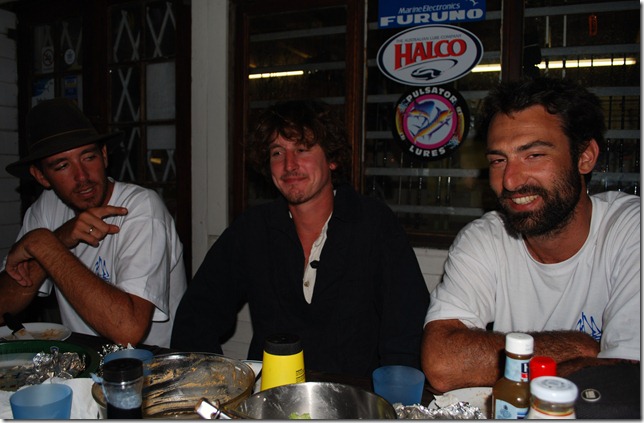 Romain, Thibault, and Pierre from S/V Reveur du Jour
Romain, Thibault, and Pierre from S/V Reveur du Jour
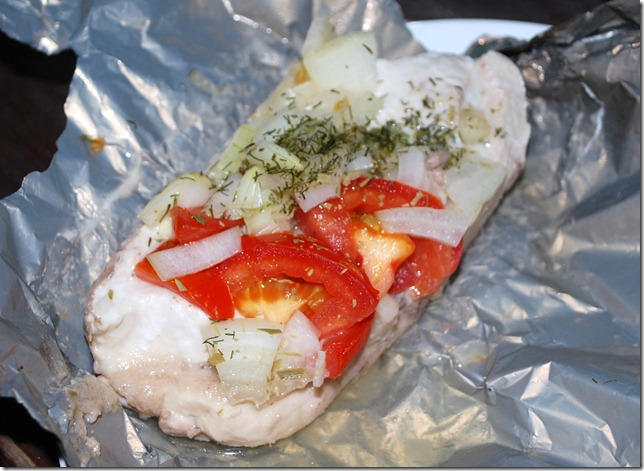 Tuna prepared by Pierre on the braii in a foil pouch with veggies and white wine (fish en papillote)
Tuna prepared by Pierre on the braii in a foil pouch with veggies and white wine (fish en papillote)
Another dreamer of the day that we have had the pleasure to befriend is Marisa. She is the Argentinean female skipper who Dallas provided with mechanical assistance back in Christmas Island. She is probably in her late 60s and is a lovely, very bright woman. We had her over for dinner the other night and learned that she got into sailing later in life after a long career as a psychologist. She was seeing a sailor who assisted her in turning the rusty hull she had purchased into an ocean-going vessel. Five years later, he decided not to go sailing, so off she went on her own! She has had crew along the way and will be joined by an Argentinean friend for the passage to Brazil, at the end of which she will have completed her circumnavigation.
Knowing that we were getting ready to leave South Africa behind ourselves, Dallas and I began to talk about things we had yet to do from a tourist perspective. Dallas noted that given that 90% of the SA population is African, our experience thus far had been “very white”, so to speak. I totally agreed that to broaden our experience, we should go for a tour of a local township. I looked around online and found the Kopanong B & B in the township of Khayalitsha, about 45 km from Cape Town, and booked a tour and one-night stay for Wednesday. Friends of ours from S/V Opportune (Norwegian skipper with an Ozzie woman crewing) decided to join us, and with some difficulty, we made it there via minibus from Cape Town. Mpho at the B & B had told us to give our phone to the driver of the minibus, and she would tell him where to drop us off, but the driver was a little irritated because he had to go out of his way. Nevertheless, he waited until we were in Mpho’s custody before driving away because he was concerned about our safety. In case you haven’t guessed why, we were pretty out of place as four white people in a township of an estimated 2 million Africans, many of whom live in shacks made of corrugated tin. However, we had an amazing experience at Kopanong, never felt as though we were in any danger, and would absolutely recommend a township tour and stay at Kopanong to anyone coming to Cape Town. I could go on and on about our experience, but Dallas is planning to write a blog devoted to the subject, so I will leave it at that.
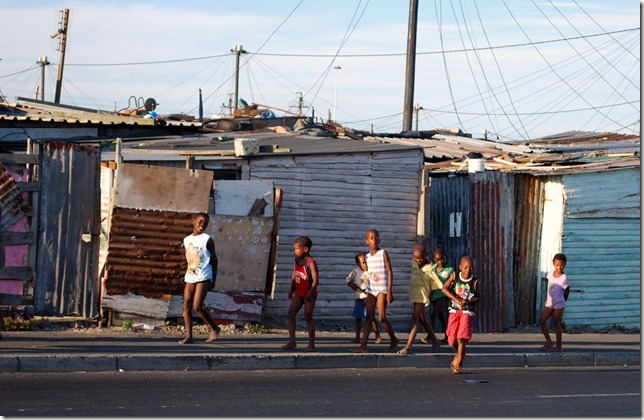 Common sights on our township tour
Common sights on our township tour
We returned to Cape Town Thursday morning and met up with our French friends for a hike up Table Mountain. It was a sunny, clear day, but the wind was whipping at 30+ knots, which made the climb especially interesting. We literally had to brace ourselves during the gusts! It was a pretty challenging climb at the pace that the skinny Frenchies set for us, but we were surrounded by interesting plant life and views of the city below, and within an hour and a half we had ascended 3,000 feet to the top. The views from the top were gorgeous (especially Cape Point), and although it was too windy to sit up there totally exposed, we had a nice picnic lunch in the lee of the rocks before making our descent.
Atop Table Mountain
We had planned to return to Simon’s Town last night, but we ended up going out on the town with the French guys instead. We shared a lot of laughs over dinner and drinks. Another highlight of the night for me was dancing at the Jo’Burg bar. This was the first chance I’d had to dance in a place full of Africans (rather than European tourists), and not only were they amazing dancers, they were really warm and welcoming to this white girl.
Today it’s blowing a gale again, as is very common for this area during this time of year. But as far as I can tell, it’s one of the only strikes against the Western Cape. I’ve been blown away by this place in more ways than one. Unfortunately, though, it’s time for us to move on. We’re watching the weather and will set sail when there’s a window (preferably less than 30 knots!), probably early next week.
Wednesday we broke up our routine of boat work and procrastinating to avoid doing boat work by taking a trip into Cape Town. Our first stop was the Brazilian consulate where we applied for visas. Brazil has an annoyingly fair approach to Visa fees. The price for a Brazilian visa is about $30, unless you come from a country that charges more than that for a Brazilian to obtain a tourist visa to visit your country. In that case, the rate is based on reciprocity: you pay what they pay. Since we’re from the US, it’s 7 times the normal rate, or more than $200 per person. Ouch! We’d already applied online, so the process was pretty standard: sign the forms, prove you’re not broke, pay the fees, and hand over a mug shot. We should have visas in a week, which is about when we’re planning to leave.
The next stop was one of Cape Town’s biggest tourist attractions, and is definitely a must-do while you’re here. Robben Island (Dutch/Afrikaans for Seal Island), is sort of like the Alcatraz of South Africa. The first political prisoners were held there starting in the mid 17th century, with some coming from Dutch colonies as far away as Malaysia. It’s also been home to non-political criminals, a leper colony, a whaling station, a quarantine station, a “lunatic” asylum, feral cats, Australian rabbits, a very lonely man named Robert Sobukwe, and of course Nelson Mandela.
Sobukwe founded the Pan African Congress, which was a competitor to the African National Congress (of which Nelson Mandela was a member). One of the key difference between the PAC and ANC was that the PAC held to more of an “Africa for Africans” stance, while the ANC encouraged membership for and co-operation with members of all ethnic groups present in South Africa. The PAC was behind the demonstrations that led to the Sharpeville massacre of 1960, when a crowd of 20,000 gathered at a police station with 20 officers (later reinforced to 150 officers). The protest was against the pass system, which heavily restricted the movement of black South Africans. Some of the protestors were armed with stones, the police had sub-machine guns, and in the end 69 protestors were killed and 180 wounded, many in the back as they were fleeing. As the leader of the protest, Sobukwe was sentenced to 3 years for incitement. When his 3 years were up, the government took advantage of a new law that allowed indefinite postponement of release and kept him for several years on Robben Island in a small house apart from all other prisoners and forbade him to speak to anyone. When he finally left the island (for house arrest and monitoring in Kimberly) he could barely speak due to atrophy of his vocal chords.
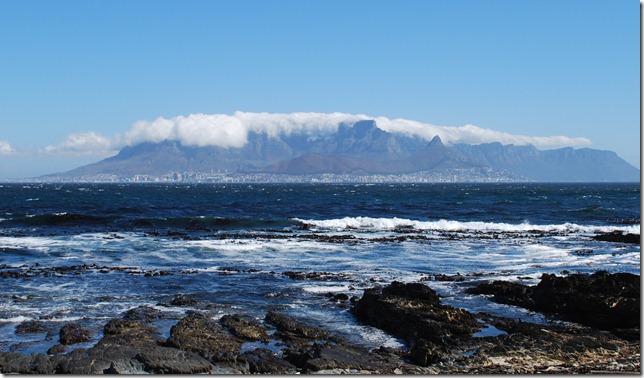 View of Cape Town and Table Mountain from the shore of Robben Island
View of Cape Town and Table Mountain from the shore of Robben Island
Our tour guide for the bus trip around the island was a humorous and entertaining Indian named Yasin Mohamed who leads VIP tours (kings, queens, Obama, Bill Cosby, etc.) and worked as a international fundraiser and representative for the PAC overseas during the apartheid years. He’d had the opportunity to meet Sobukwe, Mandela, and many others who were a part of the struggle for universal suffrage. He had plenty of interesting things to say, but a few things really stood out. One was that the Sharpeville massacre created a need for a Robben Island political prisoner unit because the government realized that black (and Indian) South Africans were now willing to die to end apartheid and obtain the right to vote. Another was how incredibly important countries like Sweden, Switzerland, India, the United States, and many others were to ending apartheid. Their decisions to support sanctions, provide educational opportunities and scholarships, and allow dissidents to live, travel, and raise funds abroad were instrumental to the efforts to end apartheid. He also discussed the apartheid government’s intentional denial of education and skilled jobs to black South Africans – most of the handful of educated blacks in the 60’s were educated by missionaries or in foreign schools, many political prisoners arrived at Robben Island illiterate, and poor education was one of the many factors leading to protests throughout apartheid. The apartheid education legacy is still impacting South Africa today.
One of the unique parts of a Robben Island tour is that the tour of the prison facilities is conducted by a former Robben Island political prisoner. That’s where we met Parks, a convicted terrorist. He was tall, shy, gentle, and had a large belly. I don’t think it’s common knowledge in the US, but after realizing that the South African government was not going to end apartheid due to peaceful protests, Nelson Mandela founded a secret, military branch of the ANC whose name translated to English is “Spear of the Nation”. It was dedicated to sabotage and other violent forms of protest. Peaceful protests and anti-government political activity had been criminalized and many political leaders, including Nelson Mandela, had been “banned”, which meant that they could not participate in political activity, meet with a group of people, or travel, and that it was illegal for anyone to publish their picture or words. Parks joined the “Spear of the Nation” and within two years was arrested and convicted of terrorist activities including being a member of a terrorist organization, recruiting people to join the organization, and illegal possession of firearms and explosives.
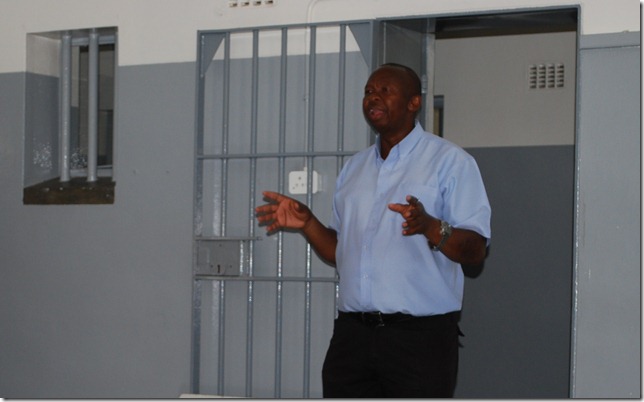 Parks telling us about his time as a prisoner on Robben Island
Parks telling us about his time as a prisoner on Robben Island
Parks spent about 7 years on Robben Island as a political prisoner and was released in 1990, about the time I was starting high school. We sat in the communal cell for general political prisoners where he was held as he told us about life in the prison. 60 prisoners lived in the communal cell, sleeping on the concrete floor using only simple mats (after 15 years of petitioning basic prison beds were finally provided). Each prisoner’s complete bedding consisted of 3 blankets that had to be folded in a particular way every morning to avoid being punished with solitary confinement and beatings. Even in the summer, the wind is cold, but during the winter is much worse, and the howling wind and rain would come into the cell through the open, barred windows. Showers were at 4:30 am three times a week with cold water in a communal shower with 3 shower heads. If any of the 60 prisoners didn’t get a chance to properly shower in the short time provided, they were punished with solitary confinement and no food for a day. Apartheid extended even to the prison, where inmates were housed and treated differently based on race. Unlike the other prisoners, black prisoners were only allowed short pants and short-sleeve shirts, were not given jackets, and were not allowed socks and shoes. They also weren’t allowed to eat bread like the other prisoners. It’s definitely compelling to hear first-hand what so many people went through for what all boiled down to the right to vote in the country where they lived. It may be an incredibly popular tourist experience, but shaking hands with Parks at the end of the tour was still something special.
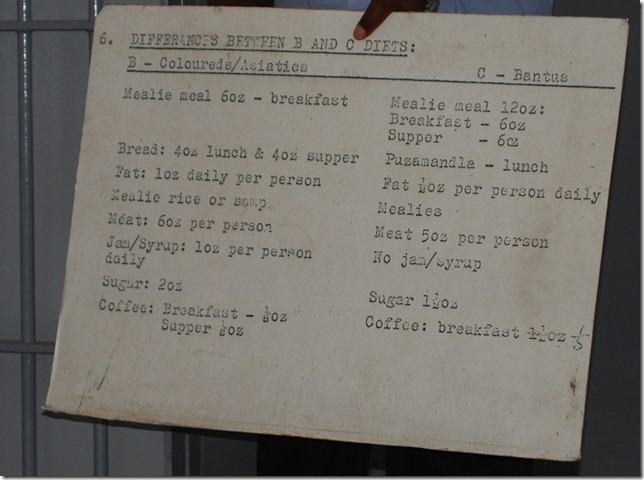 Dietary differences for coloureds/Asians versus blacks (Bantus).
Dietary differences for coloureds/Asians versus blacks (Bantus).
There are so many amazing stories from the apartheid-era Robben Island prison that it’s impossible to include them all here. Lauren and I were lucky to have a copy of Nelson Mandela’s autobiography “Long Walk To Freedom” on the boat and were able to read it in the Pacific. We’d definitely recommend it to anyone. Mandela’s story of growing up in a dirt-floored hut, leading an opposition organization, being imprisoned for 18 years, and then leading a newly integrated country is amazing not only for what it is, but for what a unique person and leader Mandela is. Africa is no stranger to men going from prisoner to Prime Minister in the course of 24 hours, but Mandela’s approach to leadership is very unique in general and especially on the African continent. During the tour we were able to see Nelson Mandela’s cell and the courtyard where the first draft of his autobiography was hidden in a corner in the garden that he started while imprisoned there (when the authorities found it, Mandela was punished by not being able to continue his correspondence studies for 4 years). Mandela and other leaders of the anti-apartheid movement were kept in cells by themselves in a unit apart from the other prisoners in an attempt to lessen their impact and influence on the other prisoners.
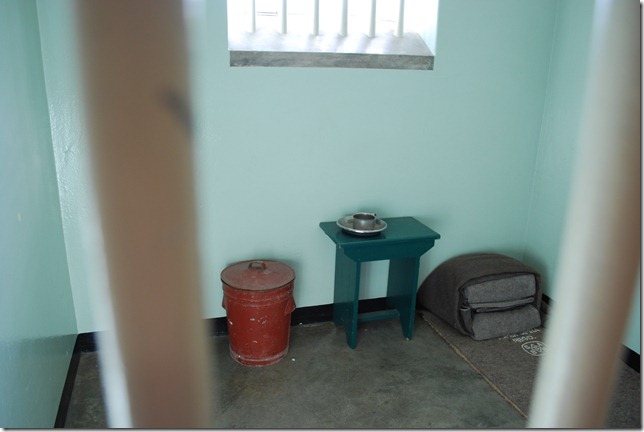 Mandela’s 2m x 3m cell. From (L) to (R): toilet, table with dinnerware, mat/bed with 3 blankets folded as required by authorities
Mandela’s 2m x 3m cell. From (L) to (R): toilet, table with dinnerware, mat/bed with 3 blankets folded as required by authorities
The ferry ride back into the wind and waves left us both surprised that we didn’t see anyone puking, although several people did look like they couldn’t have made it much longer. Back ashore the crew from Marionette was waiting for us and we enjoyed a chance to socialize with them and enjoy some good Mexican food before heading back to Simon’s Town to continue preparations for crossing the Atlantic.
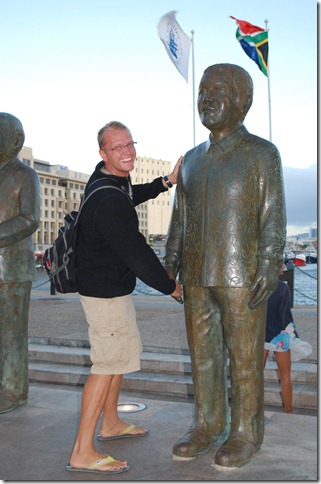 Umkhonto we Sizwe (Spear of the Nation) founder Mandela is one of four SA Nobel Peace Prize winners with bronzes at the V&A Waterfront
Umkhonto we Sizwe (Spear of the Nation) founder Mandela is one of four SA Nobel Peace Prize winners with bronzes at the V&A Waterfront
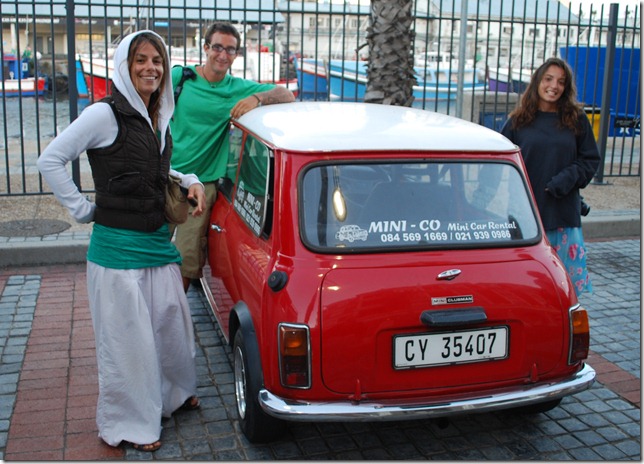 Fitting all 6 of us into Marionette’s old-school mini Cooper turned a few heads
Fitting all 6 of us into Marionette’s old-school mini Cooper turned a few heads
Most of our days of late have continued to be lacking in adventure but necessarily productive. Dallas found his way back to the engine rooms and cleaned up the fuel in both tanks. I’ve been trying to patch things up, including the dinghy (one of the chains that it hangs on has hose around it but still caused it to chafe through almost to the core) and cushion covers in the salon.
Last week I had the serendipitous opportunity to meet one of my best friends from high school in Cape Town for a trip up to the Stellenbosch region. I’ve actually known Ryan since 2nd or 3rd grade, and each year for the last 16 years, he has organized a reunion of some of our best friends from high school for a Christmas dinner. While attending the dinner last month, I learned of his business trip to Cape Town, and I’m sure you can guess my response when he asked if I wanted to join him in heading to Stellenbosch for wine tasting!
The trip from Cape Town to Stellenbosch coulda/shoulda/woulda been easy if it weren’t for the fact that determining our mode of transportation was left up to me. Haha. No, seriously. My reputation in the planning department precedes me! Dallas is definitely the planner, but since he wasn’t going and Ryan was en route, the logistics were up to me. I located the train timetables and figured out a plan for getting to CT, meeting Ryan, and then catching the train to Stellenbosch for the winery tour that I booked reservations for, but somehow I missed that the train from CT to Stellenbosch was not direct at that particular time/day. The result was that Ryan and I rode the train until the end of the line, only to look at each other and say, “could we have passed Stellenbosch without noticing?” No, we learned. We should have transferred to a different train 4 stops back. So now what? I called the tour company, and they suggested that it would be faster for us to catch a minibus (a small van that serves as a taxi) than to backtrack on the train. Initially we tried to find a minibus stop, but it turns out there is no such thing. People just stand on the side of the road until one of the minibuses comes screeching to a halt to pick them up. In our case, there were two minibuses that stopped, and young men riding in the front from both buses emerged to fight over who would get our business. The minibus that won was spray-painted black with a graffiti design on the sides and appeared to be at least as old as our boat. Ryan and I squeezed inside among the 12 others packed in like sardines, and off we rode with hip hop music blaring at full volume. Did I mention Ryan had just arrived the previous evening? I think he was quickly immersed into South African culture – thanks to my error! We eventually made it to our destination, but not before the minibus broke down (dirty fuel apparently)! Fortunately the next minibus stop was only a couple of blocks away, as it was sunny and HOT, and we were supposed to be tasting wine, not hiking!
We went to four wineries on our tour and sampled some very approachable and reasonably priced wines. The Cape region is particularly known for Pinotage, which is a blend of Pinot Noir and Hermitage or Shiraz. I found it to be smooth on the front end but spicy on the back end. Our favorite wine of the day, though, was the Shiraz Reserve from Spiced Root. Mmmmm. This came from the Fairview winery which in general was very nice and had a variety of fantastic cheeses displayed for purchase and tasting.
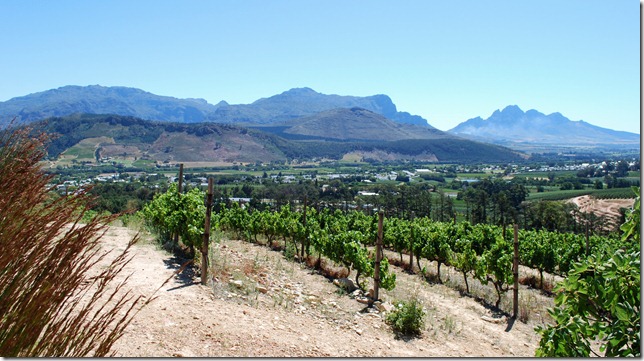 The climate and geography of this region is similar to Northern CA
The climate and geography of this region is similar to Northern CA
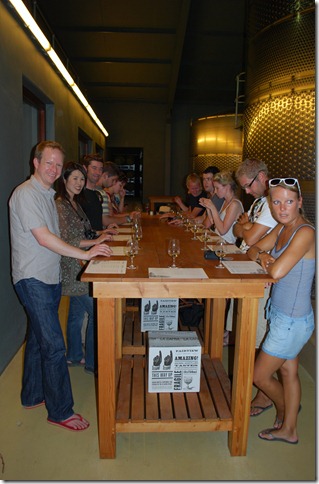 Ryan and others from the Easy Rider Wine Tour
Ryan and others from the Easy Rider Wine Tour
Part of the fun of going on an organized tour was the chance to meet others who were doing the same thing. In our case, there was a great group of tourists from Italy, Ireland, Australia, Japan, the U.S., and South Africa. By the time we got to the last winery, I had met most people and was sharing my observations about how violent Australians can be with a few others at our table, only to discover that the couple sitting across from me who I had not yet met was from Australia. Oops. Fortunately they were in total agreement with what I said!
The Western Cape region really is an excellent tourist destination, and we are reluctant to leave. However, we are excited about the next stage of our journey as well. Our next stop will be Namibia, the country northwest of South Africa that is famous for its red deserts. We will then begin our Atlantic crossing, stopping at St. Helena en route to Recife, Brazil. We are trying to time it so that we can be in Brazil for Carnival, which means that we will be able to stick around here (Simon’s Town) for another couple of weeks before we need to embark. This should give us plenty of time to address must-do boat maintenance tasks (e.g., fixing bilge pumps as usual and diagnosing the problem with the propane sniffer alarm that keeps going off…), see our friends in Cape Town again, and if weather permits, climb Table Mountain!


